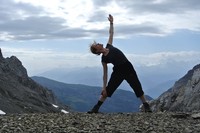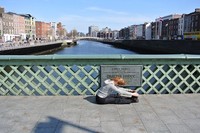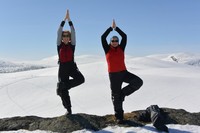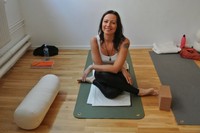Förra helgen var jag med på Revital Rauchs yinyoga-workshop på Yogahuset i Falun. Revital Rauch har en egen yogaskola i Schweiz och är en av de mest intressanta yogapersonligheter jag stött på. Hon utvecklade sin egen form av yinyoga långt innan yinyogan blev känd. Några dagar efter workshopen deltog Revital i mitt yinyogapass på Må Bättre. Därefter satt vi kvar i yogasalen och pratade om yinyoga och jag fick tillfälle att ställa henne några frågor. Nina Kaufmann fotograferade.
What is according to you the most important thing to think about when you do yoga?
To ask yourself why you do it. The idea behind yoga is for me to be in peace with myself.
How long have you been practicing yoga?
For at least 30 years. My first and most influential yoga teacher was the Yogi Yossi Ben-Yossef in Israel. He taught Hatha Yoga and he let us stay in the positions a very long time, sometimes 10 minutes. I’ve also practised other types of yoga, like Iyengar Yoga, Vinyasa Yoga , Power Yoga, Kundalini Yoga, TriYoga, Yin Yoga…
How did you develop Revital Yin Yoga?
Actually I recently discovered that what I’ve been teaching as Passive Yoga and Meridian stretching for more than 15 years has a name: Yin Yoga! So it’s quite new that I call it Revital Yin Yoga instead of just Revital Yoga. I added the word Yin, because people can imagine better what I teach and because my yoga has a lot in common with Yin Yoga:
1) staying longer in the positions
2) the choice of asanas
3) working on the meridians
4) using the individual anatomy in order to work with (not against) the body
I always had a very strong flair to passive yoga asanas. While working with people, as a dance teacher, yoga teacher and as a Body Therapist for more than 20 years (in the methods Shiatsu, Trager and Craniosacral), I learnt from people what they needed. I think that everybody has the right to get there in their own bodies, so I started to use props to help people get into the positions. I like that part of the iyengar yoga. Working with props allows you to feel comfortable in your body.
I’ve seen that you also use fluid movements and yang positions in your yoga classes.
Yes, I also teach the more active yoga form in movement-flow sequences which I today call the Yin side of Yang. It means that you perform active asanas in slow, fluent movements. Moving in slow motion has also an effect on the connective tissue. It obliges you to find your center and give you more stability and integration.
In fact you can perform most positions in a yang way or in a yin way. When you do them in a yang way you use more force and are more active. In a yin way you do them softer and in a more receiving, accepting, passive way. Still passive doesn’t mean that nothing happens. Becoming more attentive, you can sense subtler movement underneath. Developing anatomical awareness bring more clarity to your intentions, it’s never boring.
Upavista konasana in a yang way: active, working forward, wanting to come somewhere
Upavista konasana in a yin way: soft, receiving, accepting, letting go of tensions
Who do you think needs yinyoga most?
There are two types of people who need yinyoga - and that means everybody!
The two types are:
1) People who have too much connectedness and tend to have more tensions. They need to work with gravity and learn to relax tissue and mind.
2) People with hypermobility who tend to have a lack of energy flow. They need to work more with levitation.
We are never the absolute one or the other. Some parts of our body can be more connected and some can be more lax. Both are qualities present in all of us. We need to find and refind the balance.
Which is your favourite yoga posture?
Always the one I’m doing right now. It’s changing with time.
Which are your favourite tools (props) when you practice yinyoga?
It’s also changing. But mostly the floor and the wall. I love to find myself in a new environment. A chair, a seesaw in children play grounds, a tree…props are always there.
Which daily routine is the most important for you?
I don’t have routines. But I always wake up very early and then I mostly study anatomy for an hour and do yoga for 1,5-2 hours. As I cannot do the same twice, I wake up in the morning and ask my body: What do you want to do now?
Do you have a special goal with your yoga?
I have no goal. It’s a part of my life. Yoga keeps you in peace with yourself. It gives you a clear view of reality and contact with reality. It helps us looking at life as it is. It’s a good self-education, a source of energy and balance. I take care of my body, the mind follows.
Yoga saved my life. I’m 55 years old now, and I seldom visited doctors and never took medicaments. I take care of my body and mind when it needs to be taken care of. Life is sometimes very stressful. Sometimes I do the work of 2-3 people at the same time. So yoga saved me especially mentally. Still, I don’t claim that yoga is a guarantee for health and longevity. We are only human. I don’t know what will happen with me tomorrow, but today I do yoga and it makes me feel better.
Are you coming to Sweden again to give a yinyoga-workshop?
Yes, on the 2-4 of May there will be a workshop at Yogahuset in Falun.
2014-02-23 @ 12:06:00
Blandat
Förra helgen var jag med på Revital Rauchs yinyoga-workshop på Yogahuset i Falun. Revital Rauch har en egen yogaskola i Schweiz och är en av de mest intressanta yogapersonligheter jag stött på. Hon utvecklade sin egen form av yinyoga långt innan yinyogan blev känd. Några dagar efter workshopen deltog Revital i mitt yinyogapass på Må Bättre. Därefter satt vi kvar i yogasalen och pratade om yinyoga och jag fick tillfälle att ställa henne några frågor. Nina Kaufmann fotograferade.
What is according to you the most important thing to think about when you do yoga?
To ask yourself why you do it. The idea behind yoga is for me to be in peace with myself.
How long have you been practicing yoga?
For at least 30 years. My first and most influential yoga teacher was the Yogi Yossi Ben-Yossef in Israel. He taught Hatha Yoga and he let us stay in the positions a very long time, sometimes 10 minutes. I’ve also practised other types of yoga, like Iyengar Yoga, Vinyasa Yoga , Power Yoga, Kundalini Yoga, TriYoga, Yin Yoga…
How did you develop Revital Yin Yoga?
Actually I recently discovered that what I’ve been teaching as Passive Yoga and Meridian stretching for more than 15 years has a name: Yin Yoga! So it’s quite new that I call it Revital Yin Yoga instead of just Revital Yoga. I added the word Yin, because people can imagine better what I teach and because my yoga has a lot in common with Yin Yoga:
1) staying longer in the positions
2) the choice of asanas
3) working on the meridians
4) using the individual anatomy in order to work with (not against) the body
I always had a very strong flair to passive yoga asanas. While working with people, as a dance teacher, yoga teacher and as a Body Therapist for more than 20 years (in the methods Shiatsu, Trager and Craniosacral), I learnt from people what they needed. I think that everybody has the right to get there in their own bodies, so I started to use props to help people get into the positions. I like that part of the iyengar yoga. Working with props allows you to feel comfortable in your body.
I’ve seen that you also use fluid movements and yang positions in your yoga classes.
Yes, I also teach the more active yoga form in movement-flow sequences which I today call the Yin side of Yang. It means that you perform active asanas in slow, fluent movements. Moving in slow motion has also an effect on the connective tissue. It obliges you to find your center and give you more stability and integration.
In fact you can perform most positions in a yang way or in a yin way. When you do them in a yang way you use more force and are more active. In a yin way you do them softer and in a more receiving, accepting, passive way. Still passive doesn’t mean that nothing happens. Becoming more attentive, you can sense subtler movement underneath. Developing anatomical awareness bring more clarity to your intentions, it’s never boring.
Upavista konasana in a yang way: active, working forward, wanting to come somewhere
Upavista konasana in a yin way: soft, receiving, accepting, letting go of tensions
Who do you think needs yinyoga most?
There are two types of people who need yinyoga - and that means everybody!
The two types are:
1) People who have too much connectedness and tend to have more tensions. They need to work with gravity and learn to relax tissue and mind.
2) People with hypermobility who tend to have a lack of energy flow. They need to work more with levitation.
We are never the absolute one or the other. Some parts of our body can be more connected and some can be more lax. Both are qualities present in all of us. We need to find and refind the balance.
Which is your favourite yoga posture?
Always the one I’m doing right now. It’s changing with time.
Which are your favourite tools (props) when you practice yinyoga?
It’s also changing. But mostly the floor and the wall. I love to find myself in a new environment. A chair, a seesaw in children play grounds, a tree…props are always there.
Which daily routine is the most important for you?
I don’t have routines. But I always wake up very early and then I mostly study anatomy for an hour and do yoga for 1,5-2 hours. As I cannot do the same twice, I wake up in the morning and ask my body: What do you want to do now?
Do you have a special goal with your yoga?
I have no goal. It’s a part of my life. Yoga keeps you in peace with yourself. It gives you a clear view of reality and contact with reality. It helps us looking at life as it is. It’s a good self-education, a source of energy and balance. I take care of my body, the mind follows.
Yoga saved my life. I’m 55 years old now, and I seldom visited doctors and never took medicaments. I take care of my body and mind when it needs to be taken care of. Life is sometimes very stressful. Sometimes I do the work of 2-3 people at the same time. So yoga saved me especially mentally. Still, I don’t claim that yoga is a guarantee for health and longevity. We are only human. I don’t know what will happen with me tomorrow, but today I do yoga and it makes me feel better.
Are you coming to Sweden again to give a yinyoga-workshop?
Yes, on the 2-4 of May there will be a workshop at Yogahuset in Falun.














